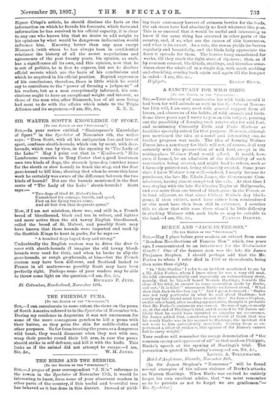SIR WALTER SCOTT'S KNOWLEDGE OF SPORT.
[TO THE EDITOR OF THE "SPECTATOR"] SIR,—In your review entitled " Shakespeare's Knowledge of Sport" in the Spectator of November 6th, the writer says: "Even Scott, with all his antiquarian lore and love of sport, confuses sleuth-hounds, which run by scent, with deer- hounds, which run by view, in the opening to The Lady of the Lake.'" May I point out that in " Kenilworth "Mike Lambourne remarks to Tony Foster that a good huntsman uses two kinds of dogs, the staunch lyme-dog (another name for the sleuth or slow hound) to track the stag, and the fleet gaze-hound to kill him; showing that when he wrote this later work he certainly was aware of the difference between the two kinds of hound? But are the hounds mentioned in the first canto of " The Lady of the Lake " sleuth-hounds ? Scott
says:—
" Two dogs of black St. Hubert's breed, Unmatched for courage, breath, and speed, Fast on his flying traces came, And all but won that desperate game."
Now, if I am not mistaken, there was, and still is, a French breed of bloodhound, black and tan in colour, and lighter and more active than the old tawny English bloodhound, called the breed of St. Hubert, and possibly Scott may have known that these hounds were imported and used by the Scottish Kings to hunt in packs, for he says :— " A hundred dogs bayed deep and strong." Undoubtedly the English custom was to drive the deer in cover with sleuth-hounds (I imagine the old tawny blood- hounds were used for this), and when he broke to slip the gaze-hounds, or rough greyhounds, at him—but the French custom may have been different, and Scotland looked to France in all matters—so possibly Scott may have been perfectly right. Perhaps some of your readers may be able to throw some light on the question.—I am, Sir, &c., RICHARD F. JIIPP. St. Columbas, Sunderland, November 12th.






















































 Previous page
Previous page